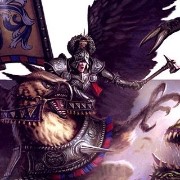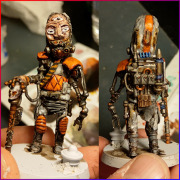|
Koramei posted:Wow ew War sucks.
|
|
|
|

|
| # ? May 16, 2024 11:47 |
|
Heavy flak also encourages the bombers to drop on the first pass even if it's not optimal, instead of casually circling around for another go.
|
|
|
|
Being a bomber crew member must have been one of the weirder experiences in the whole war. You live in England, get to go out most nights, it's almost like you're back home. And then a mission comes and you're at 25,000 feet fighting for your life for a few hours. Then if you survive it's back to relaxing at home until you have to do it again.
|
|
|
|
Anyone know what proportion of RAF pilots got shot down at some point? And what amount returned to service?
|
|
|
|
My favorite bomber story is probably this one, which illustrates the insanity of the air war in some of the more isolated theatres: http://petapixel.com/2013/10/29/honored-photograph/ Few Port Moresby stationed misfits notorious for being terrible crewmen formed a rag-tag unit and started doing their own thing, with little regard for their superiors. They commandeered (and allegedly fortified against intruders) an old B-17 carcass intended for cannibalizing, and turned it into a functioning machine (mysteriously - the base was supposed to be totally out of spare parts). Despite not being qualified for independent flight, they started volunteering for all sorts of missions, including those noone else in their right mind would volunteer for. They customized their plane with a ridiculous amount of extra firepower, and basically started using it as their makeshift barracks and HQ. Sadly for some of them the spiral of increasing aggressiveness ended badly.
|
|
|
|
Arquinsiel posted:You're sitting in a tank. Suddenly it starts rolling so hard that you don't even move until the wall hits you. Then it stops rolling, and you're still moving as fast as it was. Enjoy meeting the other wall. Liquified is probably unlikely, but the impact would probably result in a degree of splashing at least. Oh absolutely, it'd be a miracle if they weren't basically flesh bags filled with shattered and sweetbread rustico sauce afterward. Like lizards in a rock tumbler.
|
|
|
|
The Entire Universe posted:Oh absolutely, it'd be a miracle if they weren't basically flesh bags filled with shattered and sweetbread rustico sauce afterward. Like lizards in a rock tumbler. Looked it up in "Tigers in Combat," and ""Goodwood, The British Offensive in Normandy." That is Tiger 313 commanded by Oberfeldwebel Sachs, he and two others survived the ordeal but two crewmen didn't, the two in the front I assume from the description. Those who had been in the turret seem to be the ones who survived - the bomb had landed right in front of the tank and flipped it over backwards, so the driver and co-driver/radio man would've got the worst of it.
|
|
|
ProfessorCurly posted:Looked it up in "Tigers in Combat," and ""Goodwood, The British Offensive in Normandy." That is Tiger 313 commanded by Oberfeldwebel Sachs, he and two others survived the ordeal but two crewmen didn't, the two in the front I assume from the description. Those who had been in the turret seem to be the ones who survived - the bomb had landed right in front of the tank and flipped it over backwards, so the driver and co-driver/radio man would've got the worst of it. I have this book. Pretty loving sweet.
|
|
|
|
|
steinrokkan posted:My favorite bomber story is probably this one, which illustrates the insanity of the air war in some of the more isolated theatres: I've heard about this story before. There's a movie that needs to be made about this story. One version of the story has someone at the base attempting to count the holes in the plane and then giving up. He said "After the first thousand holes it just didn't matter anymore."
|
|
|
|
What tactics did the conquistadors use in the New World? Someone referred to Cortez using tercios, which strikes me as a little too rigid to be used in jungle warfare, but I don't know anything about the period. (actually sperging about pre-Columbian wars would be cool too.)
|
|
|
|
Darth Brooks posted:I've heard about this story before. There's a movie that needs to be made about this story. One of the guys was due to go home in 3 days and had the chance to not to fly that mission.Dude went up and got killed.
|
|
|
|
StashAugustine posted:What tactics did the conquistadors use in the New World? Someone referred to Cortez using tercios, which strikes me as a little too rigid to be used in jungle warfare, but I don't know anything about the period. HEY GUNS fucked around with this message at 23:56 on Feb 10, 2014 |
|
|
|
IIRC the only reason Cortez made it out of south America alive was because the Aztecs wanted to wait until his column (in ragged retreat) exited the forest and reached a massive open basin. Their reasoning was that they'd be able to use their overwhelming numbers to utterly crush him, rather than piss away troops piecemeal by harrying him in the jungle. Unfortunately they had no idea how devastating cavalry was and Cortez took full advantage of this. Gunpowder didn't have much to do with it one way or another.
|
|
|
|
|
Cortez never set foot in South America.
|
|
|
|
gradenko_2000 posted:Aircraft maintenance crews went through such things too. Hosing down the inside of a B-17, or the terrible silence over the radio as a bomber makes a belly landing with a ball turret that couldn't be retracted Any excuse to post The Death of the Ball Turret Gunner: From my mother's sleep I fell into the State, And I hunched in its belly till my wet fur froze. Six miles from earth, loosed from its dream of life, I woke to black flak and the nightmare fighters. When I died they washed me out of the turret with a hose. "A ball turret was a Plexiglas sphere set into the belly of a B-17 or B-24, and inhabited by two .50 caliber machine-guns and one man, a short small man. When this gunner tracked with his machine guns a fighter attacking his bomber from below, he revolved with the turret; hunched upside-down in his little sphere, he looked like the foetus in the womb. The fighters which attacked him were armed with cannon firing explosive shells. The hose was a steam hose." -- Jarrell's note.
|
|
|
|
European tactics and equipment were fairly irrelevant in terms of the conquest. Remember that Cortez and co. showed up with 1,000 - 1,400 men, of which only a few dozen were cavalrymen. Against this, the Aztec Empire/Triple Alliance could raise hundreds of thousands of men. Tenochtitlan was actually the largest city in the world west of Istanbul, far bigger than any city in Iberia. Cortez won because he leveraged the shock of European arrival to pull off a diplomatic coup amongst the peoples subjugated by the Aztecs and their allies. Tlaxcala, Totonac, etc. heavily resented being ruled from Tenochtitlan and were waiting for any chance to rebel. Add to this the fact that there was a lot of weird religious interpretations floating around the figure of Cortez as a God (either as Quetzalcoatl himself or as his emissary). In fact, after scuttling his ships, Cortez and his men were set upon by thousands of Tlaxcalans, who managed to surround them, and according to Spanish records, would've probably wiped them out. Tlaxcalan elders, however, saw an opportunity in allying with the Spanish vs. Montezuma. Cortez essentially took over the alliance, and marched on the Aztecs, who actually greeted him peacefully at first. At this point in time, Cortez counted with a confederation of native allies that could put 200,000 men into the field, effectively matching the Aztecs in numbers. This is even without mentioning all the stuff that went down in Tenochtitlan, with a lot of domestic politics getting mixed into the mess. Simply put, the narrative that the Spanish showed up and won due to gunpowder is completely wrong, the Spanish won the conflict through purely conventional means, much in the same way they would do so in the Old World. e: vvv disease is relevant, yes, but before the disease happened the Spanish had already clashed on the field of battle with the natives, and had not magically won due to horses and guns. Ghost of Mussolini fucked around with this message at 09:26 on Feb 11, 2014 |
|
|
|
Let's not forget smallpox. That was significant as well.
|
|
|
|
|
jng2058 posted:Let's not forget smallpox. That was significant as well. I think that's more of a longer term thing rather than the critical couple years that Cortez conquered the Aztecs with.
|
|
|
|
I'm generally familiar with how the conquest went down (although some of it's new to me and it's all interesting), but I was specifically wondering if the fighting was conducted with conventional European field tactics like the tercio. Off the top of my head, the lack of cavalry among the enemy might make pikes less attractive, but you guys are the ones with degrees.
|
|
|
|
I thought he used tank destroyers
|
|
|
|
jaegerx posted:I thought he used tank destroyers Close enough, he actually used superior European technology to deploy river boat destroyers. http://www.youtube.com/watch?v=ZDlra8SsuXc
|
|
|
|
jaegerx posted:I thought he used tank destroyers No that was Pizarro.
|
|
|
Shimrra Jamaane posted:I think that's more of a longer term thing rather than the critical couple years that Cortez conquered the Aztecs with. Siege of Tenochtitlan says otherwise.
|
|
|
|
|
StashAugustine posted:I'm generally familiar with how the conquest went down (although some of it's new to me and it's all interesting), but I was specifically wondering if the fighting was conducted with conventional European field tactics like the tercio. Off the top of my head, the lack of cavalry among the enemy might make pikes less attractive, but you guys are the ones with degrees. Cortez didn't have the kind of force that could use Spanish tercio tactics and the tercio really came into its own late in the 1500s, rather than in Cortez's time.
|
|
|
|
Shimrra Jamaane posted:I think that's more of a longer term thing rather than the critical couple years that Cortez conquered the Aztecs with. Smallpox absolutely ravaged the Axtecs during 1520-1521, in the immediate aftermath of La Noche Triste. Perhaps 40-50% of the population died, either from the disease, or starvation following the failed harvest (which failed because smallpox incapacitated most of the farm labour). Moctezuma's successor, Cuitláhuac, was among those killed by smallpox.
|
|
|
|
WEEDLORDBONERHEGEL posted:I know nothing about Central America, but I do know that a fortress/citystate in my home state was never taken until the Spanish prolonged a cannon up the side of the mesa it was built on, and recapitulated the result of the early Italian Wars in a single engagement. It's not actually in that article though, which is a shame, but there are pictures of Acoma. A perfect strong place--until gunpowder artillery. (They have since built a bridge into it. Living on top of one of the world's greatest strong places is fine, but being able to drive to the Albertson's for some orange juice is better.) Apparently pre-colombian mexico was full of fortifications, unfortunately all I know on the topic I learned from one presentation in which an archeologist used satellite imagery and topologic maps to reconstruct ancient state boundaries based on the position of defensive structures their and use over time. Because this anecdote is rather boring here's a couple pictures of the Peruvian fortress of Kuelap, built in the 9th century AD:   edit: This post got me curious about accounts of the Spanish conquest, which led me to "The Broken Spears: The Aztec account of the Conquest of Mexico." I was just skimming the introduction which included some cool quotes regarding, the ah, Spanish tactics. Upon encountering an Aztec religious festival: quote:They ran in amongst the dancers, forcing their way to the place where the drums were played. They attacked the man who was playing and cut off his arms. Then they cut off his head, and it rolled across the floor. Squalid fucked around with this message at 02:43 on Feb 11, 2014 |
|
|
|
I assume all the scrubland around it would've been cleared when it was in use and all that is just re-growth?
|
|
|
|
|
Probably, I imagine all the surrounding land would have been under intensive cultivation back when it was inhabited. The fortress was abandoned during the Spanish conquest. Per wikipedia the ruins extend 600 meters in length and 110 meters in width, and sit 3000 meters above sea level. To put that in perspective Denver Colorado is only 1,600 m above sea level. Edit: Another quote from Aztec witnesses of the conquest quote:The “stags” came forward, carrying the soldiers on their backs. The soldiers were wearing cotton armor. They bore their leather shields and their iron spears in their hands, but their swords hung down from the necks of the “stags.” Squalid fucked around with this message at 02:57 on Feb 11, 2014 |
|
|
|
PittTheElder posted:Smallpox absolutely ravaged the Axtecs during 1520-1521, in the immediate aftermath of La Noche Triste. Perhaps 40-50% of the population died, either from the disease, or starvation following the failed harvest (which failed because smallpox incapacitated most of the farm labour). Moctezuma's successor, Cuitláhuac, was among those killed by smallpox. Well I learned something new yay!
|
|
|
|
Can someone do a breakdown of North Africa in WW2? I was listening to Three Moves Ahead last night and they were talking about El Alamein and I realized that I my knowledge of the theater was "Italians attack, British throw them back, Rommel arrives, sieges/gets stuck at Tobruk for a while but eventually takes it, Operation Crusader happens but I don't know what that is, there's a stalemate for a long time while Montgomery trains troops and builds up tons of supplies then El Alamein is just Monty smothering Rommel after crossing large minefields" e: I am familiar enough with what happens right before/during Torch all the way to the final surrender at Tunis. gradenko_2000 fucked around with this message at 04:38 on Feb 11, 2014 |
|
|
|
gradenko_2000 posted:Can someone do a breakdown of North Africa in WW2? I was listening to Three Moves Ahead last night and they were talking about El Alamein and I realized that I my knowledge of the theater was "Italians attack, British throw them back, Rommel arrives, sieges/gets stuck at Tobruk for a while but eventually takes it, Operation Crusader happens but I don't know what that is, there's a stalemate for a long time while Montgomery trains troops and builds up tons of supplies then El Alamein is just Monty smothering Rommel after crossing large minefields" Also don't forget that the British probably could have won in North Africa in 1941 if they didn't decide to stop their rout of the Italians and go to Greece.
|
|
|
|
Squalid posted:Apparently pre-colombian mexico was full of fortifications, unfortunately all I know on the topic I learned from one presentation in which an archeologist used satellite imagery and topologic maps to reconstruct ancient state boundaries based on the position of defensive structures their and use over time. Because this anecdote is rather boring here's a couple pictures of the Peruvian fortress of Kuelap, built in the 9th century AD: Who was the archaeologist and where can I read more about the state boundaries of pre-columbian civilizations? This is really interesting to me right now for some reason.
|
|
|
|
He was studying for his Masters and gave the presentation for an intro to ArcGIS class, not something that was published, sorry. He cited other more professional authors though so I'm sure we could dig up some material. This is why I instantly tried to change the subject after bringing it up I should clarify, the "fortifications," in this presentation weren't very impressive and were little more than watchtowers or villages; that said I definitely remember reading somewhere about the use of fortified positions in pre-columbian mexico. Blah Squalid fucked around with this message at 05:35 on Feb 11, 2014 |
|
|
|
Tomorrow I'll be going to Belgium to attend a workshop on Battlefield Emotions 1550-1850, and I'll be sure to pass on anything cool I hear to you guys. I'm not presenting, but I'm looking forward to a stirring discussion of how to write about the feelings of people who don't write about their feelings.
|
|
|
|
Glorgnole posted:Who was the archaeologist and where can I read more about the state boundaries of pre-columbian civilizations? This is really interesting to me right now for some reason. Oo, oo, pick me. So the Mesoamerican 'state' is a pretty interesting one. It's based around (at least in the Nahuatl areas) the altepetl, often translated as 'city-state' though it's a bit more... complicated than that. The literal translation is 'water and mountain' but is often used to, e.g. refer to people. As in 'the whole alteptl showed up for the ball game.' It's often called an 'ethnic city-state.' Each altepetl is comprised of subunits that are essentially the altepetl in miniature. Farmers, artisans, nobles, the whole kit and caboodle. They would rotate responsibilities (corvee labor, tribute taxes to the king, overseeing state functions like legal cases) on a yearly basis. These sub units had their own land claims, and an altepetl might actually simply have several central villages, one from each tribe instead of a contiguous city. Each altepetl would have it's main god, each subunit would have a shrine to the altepetl god and their own subunit's god. Some altepetls were comprised of several altepetls (just as altepetls were comprised of subunits) and yes that's confusing. The Mexica (pronounced me-she-ka, the x is a sh sound in medieval Spanish) are actually an example. Tenochtitlan was actually contiguous with the city of Tlatelolco, which was also part of the 'Aztec' alliance. But, you know, not ruled by Montezuma at all.* TOTALLY different government and 'ethnic identity.'** Conquest wasn't really a thing the Aztec's did. They have a sort of founding myth in which they migrated into the area (along with the rest of the nahuatl speaking people) but they showed up late and pissed a bunch of people off and sort of had to set up shop out in the middle of nowhere. One thing about the Aztec Empire was that is wasn't really how we would imagine an empire. The Aztecs would show up, knock heads, take captives, demand tribute, and force the local king to put up a shrine to their god (which wasn't the same as demanding they all convert or something, more a traditional way of, well, teabagging an enemy. Showing dominance, or, by destroying an intruding shrine, defiance.) Reordering land didn't seem to be a big concern, but tribute and captives were. Gold wasn't terribly valuable to the natives, sure it was pretty, but jade and especially bird feathers were a much bigger deal. The Mayan's had a bit more of a traditional city-state/god-king vibe going, while the Mixtecs had an Nahautl-ish set up, only with female rulers being much more common. Royal marriages would lead to states (even though geographically seperated) unifying totally- but only for that one generation of rule. * One of the native accounts we have is from the Tlatelocans, who basically say 'once the rafts with the cannons showed up all the Mexica ran through the city, clogging up the streets as our warriors tried to gather and fight.' It was particularly frustrating because they felt the Mexica had basically gotten them into the mess in the first place and they'd had their food interdicted along with Tenochtitlan. **I mean, everyone spoke Nahuatl, but people thought of themselves in terms of their altepetl or in terms of their subunit. There was no 'nahuatl pride' opposed to, say, a Mayan model, aside from a little 'people who speak clearly' and 'mushy mouthed barbarians' aside. e: I should mention, the altepetl became the sort of base unit of the Spanish conquest. The church parishes were based on the system, as well as the encomiendas, which were kinda semi-feudal grants to the original conquistadores and their descents, entitling them to the labor/tribute that would have gone to their king otherwise. Oh! Yeah, the altepetl kings were elected... by the nobility of the subunits... from a pool consisting of the male relatives of the king. Uncles, brothers, cousins, sons, nephews whoever. the JJ fucked around with this message at 05:44 on Feb 11, 2014 |
|
|
|
the JJ posted:The Mayan's had a bit more of a traditional city-state/god-king vibe going, while the Mixtecs had an Nahautl-ish set up, only with female rulers being much more common. Royal marriages would lead to states (even though geographically seperated) unifying totally- but only for that one generation of rule. Meesh-teks? the JJ posted:The Mexica (pronounced me-she-ka, the x is a sh sound in medieval Spanish) are actually an example. Is this the etymological root of Chicano? Starting from the second syllable? Frostwerks fucked around with this message at 06:26 on Feb 11, 2014 |
|
|
|
Frostwerks posted:Is this the etymological root of Chicano? Starting from the second syllable?
|
|
|
|
What'd you do to get kicked out of special collections
|
|
|
|
E: nv I'm reading a book about Ivan the Terrible, and its kind of striking what kind of mess that medieval Europe was in terms of different kings claiming different lands for different reasons. When did the modern idea of state and nation as a unified whole start to appear? Mr. Sunshine fucked around with this message at 08:22 on Feb 11, 2014 |
|
|
|

|
| # ? May 16, 2024 11:47 |
|
Frostwerks posted:Meesh-teks? More or less, yeah.
|
|
|









 Yes, it's like a lava lamp.
Yes, it's like a lava lamp.



























